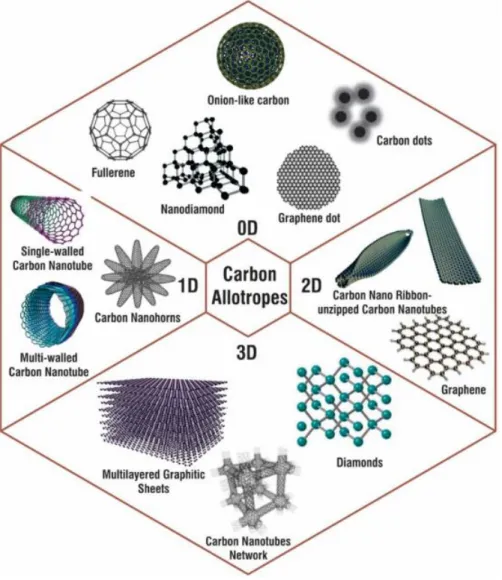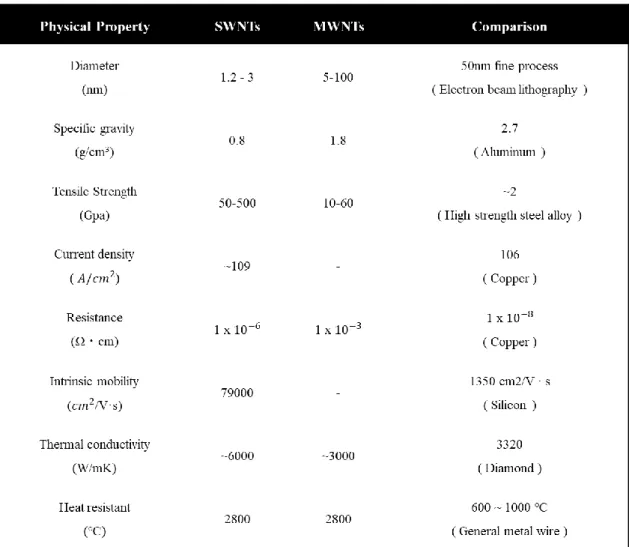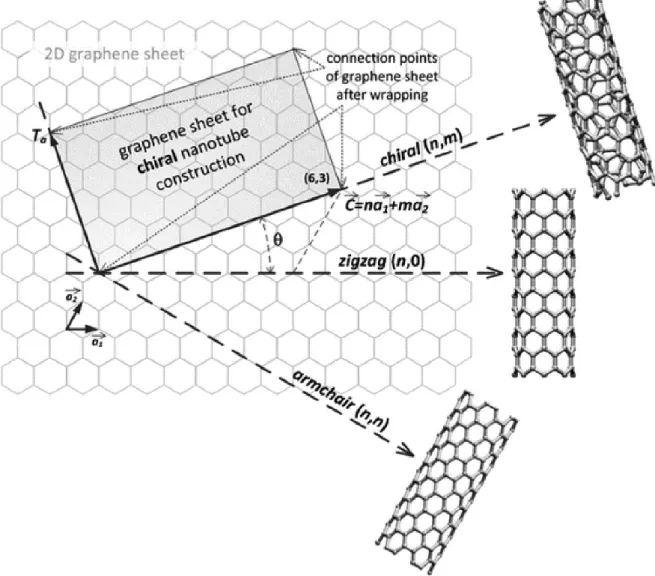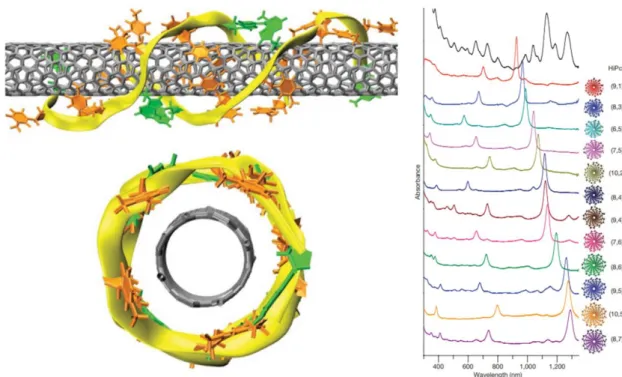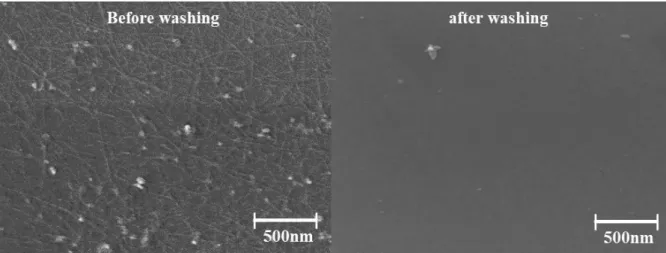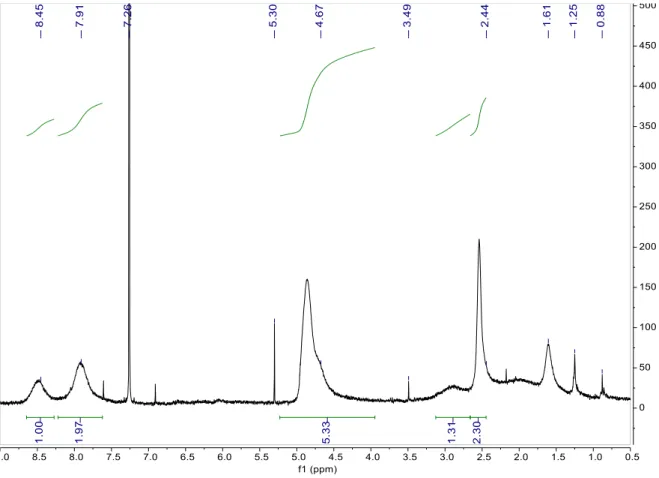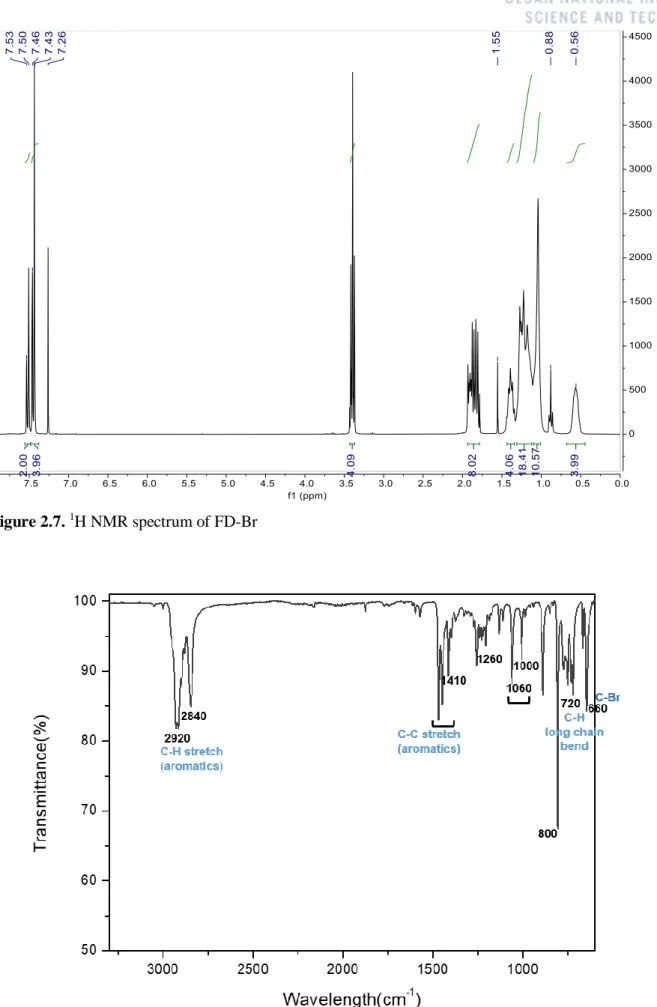It is also necessary to find a suitable density of SWNT layers on a designated active area to achieve high and uniform performance. To solve these problems and utilize the SWNTs, a chemical immobilization method of SWNTs on a wrapping polymer substrate is proposed which can form chemical bonds between sc-SWNTs and the adhesive layer. The resistance value of SWNTs FETs showed almost the same value without change even after sonication washing with PBS solution.
Table 1] Physical and electrical properties of SWNTs and MWNTs ··· 3 [Table 2] Resistance difference of SWNT-based biosensors to confirm the effect of.
Backgrounds of carbon-nanotubes
Structures and electrical properties of carbon-nanotubes
In geometric structures of carbon bonds, there are two achiral SWNTs known as armchairs (θ = 30°) and zigzags (θ = 0°). Graphene sheet with defined chiral angles and vectors and various SWNTs structures depending on chirality.

Purification method of selective dispersion by conjugated polymers
In the conjugated polymer structure, the main chain plays an important role in selectivity, and the graded chirality is determined by the winding angle of the main chain and the type of copolymer derivations. 1927 The length of the alkyl side chains of the conjugated polymers determines the types of carbon nanotubes for packaging.22 It has been reported that when the length of the side chains is increased, it is possible to sort carbon nanotubes with a larger diameter. The molecular weight of a polymer is another factor that affects its selective dispersion.28 There is a report that polymers with a molecular weight of 10 kDa or more can be successfully used as shell polymers to achieve efficient charge mobility of electronic devices. Even if a bundle containing a large amount of metallic carbon nanotubes is used, there is a result that high-purity sc-SWNTs can be obtained by polymer packing.29.
Among them, polyfluorene derivatives were used to selectively disperse SWNTs and provide much improved optical spectra.
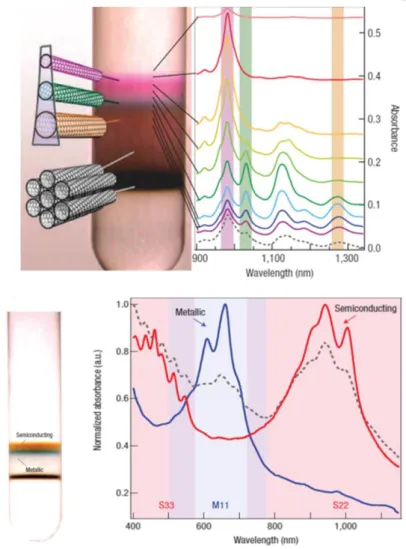
Single-walled carbon nanotubes field effect transistors
Electrochemical biosensors based on carbon-nanotubes
Motivations
Materials and Characterization
Materials Synthesis
- Synthesis of 4-(Allyloxy)benzophenone, ABP
- Synthesis of 4-(3’-Chlorodimethylsilyl) –(propyloxy)benzophenone, BPS
- Synthesis of 5-acryloyloxyisophthalic acid, APA
- Synthesis of Di(propargyl)-5-(Acryloxyloxy)isophthalate, DPAP
- Synthesis of poly(dipropargyl-5-(acryloyloxy)isophthalate-r-propargylacrylate,
- Synthesis of 2,7-dibromo-9,9-bis(12-bromododecyl)9H-fluorene, FD-Br
- Synthesis of 2,7-dibromo-9,9-bis(12-azidododecyl)9H-fluorene, FD-N 3
- Synthesis of 2,2'-(9,9-didodecyl-9H-fluorene-2,7-diyl)
- Synthesis of poly(didodecylfluorene-alt-bis-azidododecyl-fluorene),
In a three-necked round-bottom flask, 5-hydroxyphthalic acids (5-HPA, 2 g, 11 mmol) were added to 20 mL of 2M NaOH solution, and the reaction mixtures were stirred in an ice bath for about 20 min. at 4 °C. Upon addition of cold diluted HCl solutions to the mixture to neutralize to pH 7, the APA products began to precipitate as a white powder. The mixture was cooled in an ice bath at 4 °C for 30 min under nitrogen atmosphere.
The solvent was removed by an evaporator and the crude material was dissolved in chloroform and filtered. Then using hexane and ethyl acetate, the residue was purified by silica column to give the product as a white powder (yield: 28%). After that, the crude materials were extracted with chloroform and the organic phases were washed with water.
Using hexane, the residues were purified through a silica column and recrystallized by ethanol and hexane to give the product as a white solid (4.00 g, 64%). The crude product was then extracted with chloroform and the organic phases were rinsed with water. Using hexane and ethyl acetate, the residues were purified through a silica column and recrystallized by ethanol and hexane to give the product as a white solid (5.36 g, 83%).
Then the residues were extracted with chloroform and the organic phases were rinsed with water. Using activated carbon, the residues were purified through a silica column with dichloromethane and recrystallized by methanol and acetone, yielding the product as a white solid (3.98 g, 70%). Under a nitrogen atmosphere, 0.78 ml of degassed 25 wt% aqueous tetraethylammonium hydroxide solution was added dropwise to the reaction mixtures.
Then the crude material was extracted with chloroform and the organic phases were washed with water three times.
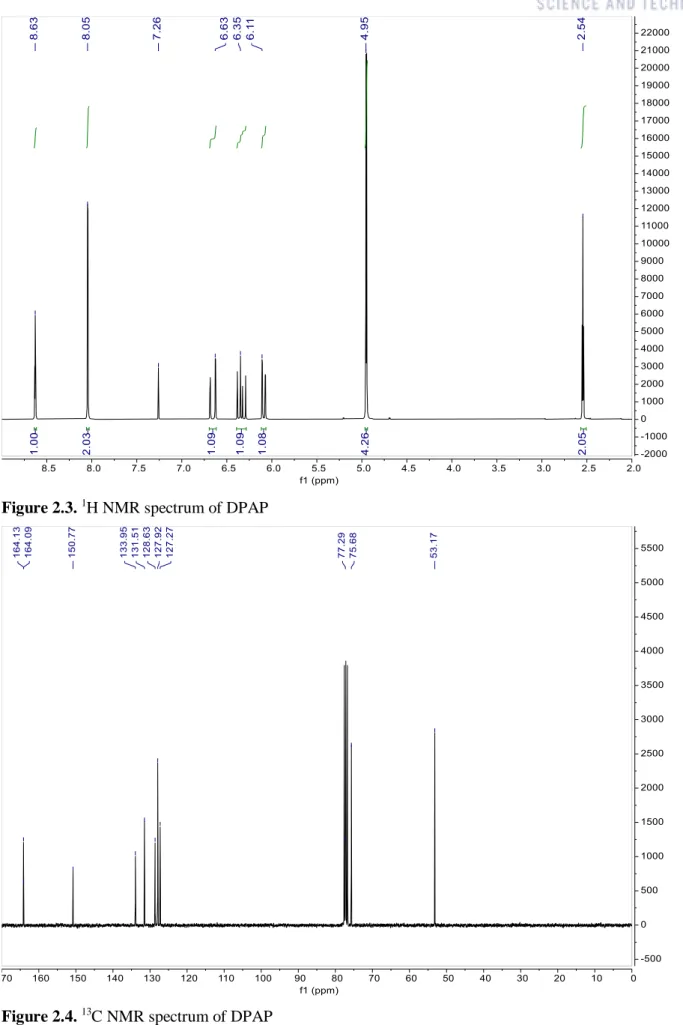
Enrichment of the selectively sc-SWNTs dispersion by polymer extraction
BPS immobilization on SiO 2 surface
Formation of alkyne-functionalized patterned polymer film by UV attachment
Procedure of Click reaction in SWNTs solution
Electrode deposition for top contact structures
First, only sc-SWNTs were selectively dispersed by wrapping polymer to resolve the mixed properties and bundling caused by π-π interaction of SWNTs. This synthesized fluorene polymer with azide group was used to purify sc-SWNTs of plasma torch SWNTs (Nanointegris, RN-220). However, if the wrapping polymer contains azide groups in its side chain, it is difficult to separate sc-SWNTs with high purity because metallic SWNTs also have interactions with polymers containing high concentrations of nitrogen atoms due to nitrogen's rich electrons. .5 Among the results of the selective dispersions of sc-SWNTs using the conjugated polymer wrapping method, there are some results that the purity of sc-SWNTs was increased as metallic SWNTs are selectively removed by silica gels.45 When using of the affinity of silica gel and m-SWNTs, high purity of sc-SWNTs was selectively separated.
The results of selective sc-SWNTs dispersion by conjugated polymers were confirmed by UV-vis and Raman spectrum. The absorption spectrum of the enriched SWNTs was measured to identify the selectively separated species of sc-SWNTs from the solution by UV-vis spectroscopy. For a more detailed analysis of the selective sc-SWNTs distribution, Raman spectrum was obtained as shown in Figure 3.2.
RBM relative intensity can be used to describe the electrical properties of carbon nanotubes.46 In the RBM region, sorted sc-SWNTs with 0.9-1.5 nm diameters were investigated with Raman shifts of 100-300 cm-1. In separated sc-SWNTs samples, the intrinsic peaks of G and G' bands were observed, but the D bands indicating defects were not observed. This result means that m-SWNTs were removed and only undamaged sc-SWNTs were selectively enriched by conjugated polymer wrapping method.
Then, the Click reaction between the substrate alkyne and SWNT azide took place by mixing the aqueous solution of the catalyst and the sc-SWNT inks by sonication in a bath for 5 minutes at 50℃. But the sc-SWNT film precisely patterned only between source and drain showed improved performance by reducing leakage currents and device-to-device interference. The interference of the selective dispersion of nitrogen atoms with rich electronegativity was overcome by the adsorption of metallic SWNTs with silica gel, resulting in higher purity of sc-SWNTs.
The purified SWNTs having azide functional group react with the alkyne-based adhesive layer by Click reaction.
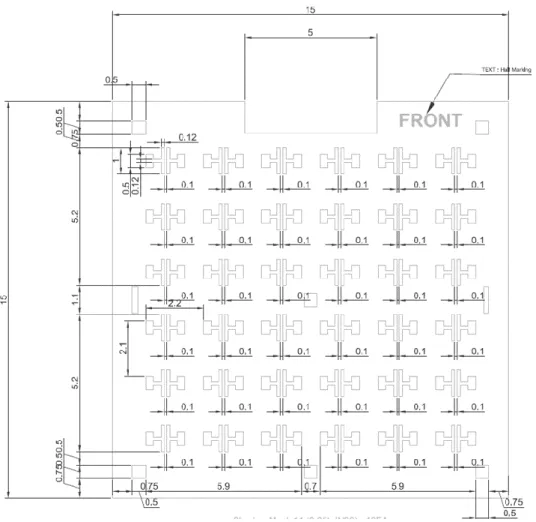
Attachment of antibodies via 1-pyrenebutanoic acid succinimidyl ester (PBASE)
Detection of Aβ1-42 using the developed SWNTs-based platform
Enrichment of sc-SWNTs dispersion by polymer extraction
Mixed properties and strong intermolecular π-π interactions are unique problems of SWNTs.41 Also unstable immobilization of SWNTs on the substrate and low device reproducibility are major obstacles in the development of SWNTs based biosensors.3537. Click reaction was used to solve the remaining problems of low stability and reproducibility of SWNTs film. To prepare these polyfluorene derivatives, a monomer called FD-N3 with C12 chain length and azide groups at the end of chains was synthesized from 2,7-dibromofluorene. From 2,7-dibromofluorene, FD-Br was synthesized by alkylation of 1, 12-dibromododecane under the reaction TBAB-NaOH catalytic system.42 43 The bromine of FD-Br was replaced with azide group using sodium azide in DMF solution to to obtain FD-N3.
From 2,7-dibromo-9,9-didodecyl-9H-fluorenes, FD-pinacolborane was synthesized by condensation reaction with bis(pinacolato)diboron.44 The alternating polymer P(FD-N3) was synthesized using FD-N3 and FD -pinacolborane monomers via Suzuki coupling. For selective sorting of sc-SWNTs, plasma torch SWNTs were dispersed in toluene solution of P(FD-N3) polymer with silica gel by horn sonication. The remaining unpacked polymer in the extracted suspension was removed by filtration, and enriched SWNTs on filter paper were redispersed in toluene.
As shown in Figure 3.1, peaks of enriched SWNTs showed sharper semiconducting transition peaks in 700-1100 nm, 450-550 nm bands for S11, S22 respectively after sorting processes. In the radial breathing mode (RBM), lattice vibrations of SWNTs are an inherent property of specific SWNTs. Because metal SWNTs with a diameter of 1.3-1.5 nm resonated with an excitation energy of 1.59 eV in this RBM region, the resonance with metal SWNTs appears around 160 cm-1, as shown in Figure 2.16. 47. After the toluene enrichment process with silica, these metal peaks were not observed from the Raman spectrum in the same range.
The damage to the SWNT structure can also be confirmed in the RBM mode, as shown in Figure 3.3. The Raman scattering spectrum of SWNTs is shown by two strong peaks at 1580 and 2700 cm−1, called G-band and G'-band, which is represented as the intrinsic electrical properties of SWNTs.48 In the presence of defects in SWNTs, D band (D means defect or disorder) is observed at about 1350 cm-1.
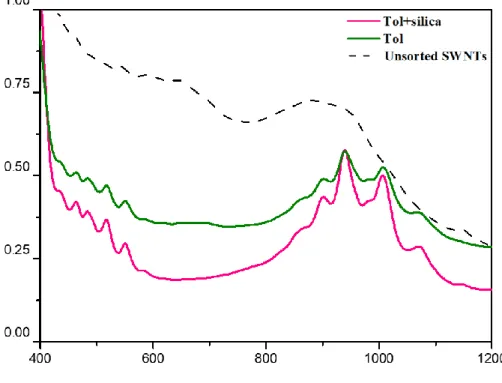
Fabrication of patterned SWNTs field effect transistor
But it was confirmed that the pattern of the adhesion layer is possible up to 20 μm and 5 μm. Patterned SWNTs film was formed by the click reaction with the pre-patterned polymer layer and it was confirmed by Raman spectroscopy shown in Figure 3.8. The density change and stability of the patterned SWNTs film depending on the Click reaction time were observed with scanning electron microscopy (SEM).
To confirm the electrical properties of the fabricated SWNTs films, source and drain electrodes were deposited on the SWNT networks for the structure of top-contact bottom-gate FETs. Also, carbon nanotube FETs themselves exhibit bipolar behavior, however, they exhibit p-type characteristics from absorbing moisture in the atmosphere. As shown in the I-V curves, the most obvious advantage of the sample with patterned active regions is that the deviation of the transfer curve is significantly reduced compared to the sample whose devices are physically isolated with cutters.
As shown in Figure 3.13, the I-V curves were measured before and after washing with PBS buffer with 20 samples. In order to ensure the stability of the SWNTs films before the washing process of the biosensors, the resistance was measured before and after washing with PBS solution. On-Chip Chemical Self-Assembly of Semiconducting Single-Walled Carbon Nanotubes (SWNTs): Towards Robust, Scale-Invariant SWNT Transistors.
Effect of polymer molecular weight and solution parameters on the selective dispersion of single-walled carbon nanotubes. Removable and recyclable conjugated polymers for highly selective and high-efficiency dispersion and release of low-cost carbon nanotubes. A hybrid enrichment process combining conjugated polymer extraction and silica gel adsorption for high-purity semiconducting single-walled carbon nanotubes (SWCNT).
Engineering the structural topology of pyrene-based conjugated polymers for the selective sorting of semiconducting single-walled carbon nanotubes.
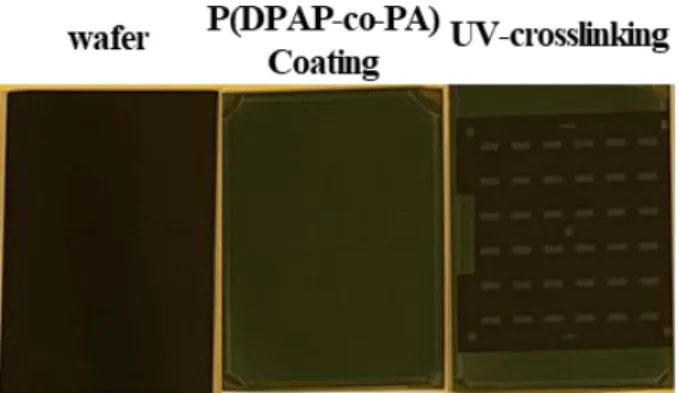
Applications as biosensors
